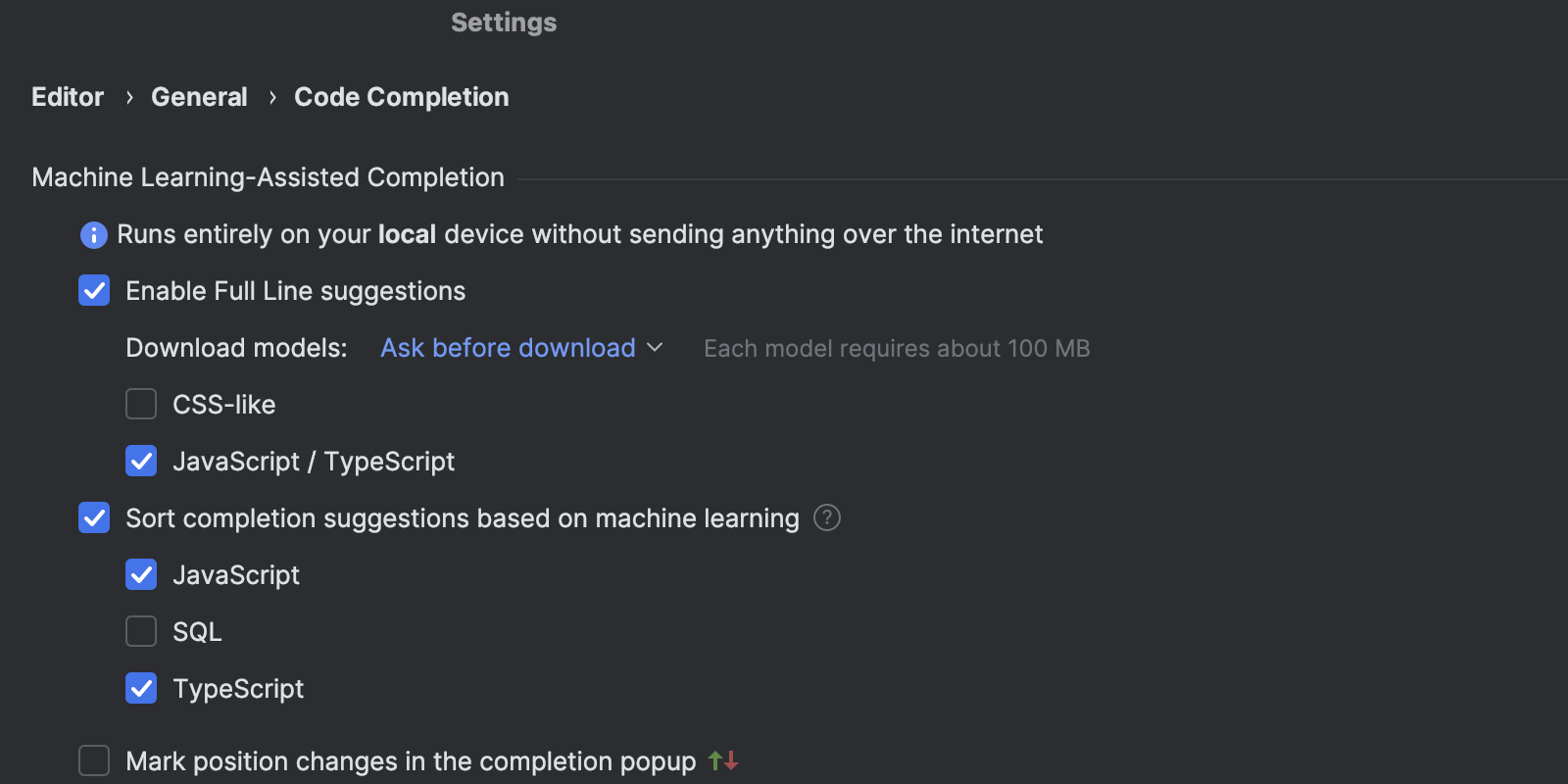Full Line Code Completion in JetBrains IDEs: All You Need to Know
Programming with AI is still a highly divisive topic, but there’s no denying that more and more developers are starting to incorporate AI into their daily workflows. Whether you’ve already picked your side in the debate or are still undecided, we’ve got a new feature in v2024.1 of JetBrains IDEs that might just pique your interest – full line code completion. It’s AI-powered and runs locally without sending any data over the internet.
In this blog post, we’ll tell you more about what full line code completion is, how it works, what languages are supported, and how you can provide feedback about it to us.
What is full line code completion in JetBrains IDEs?
This new type of code completion was added to JetBrains IDEs with the latest 2024.1 update. As you can see below, it takes the form of gray-toned, single-line suggestions that complete lines based on the context of the current file:

These suggestions are powered by specialized language models that we’ve trained specifically for different languages and frameworks. The models run locally without sending any code over the internet.
Full line code complеtion is currently available for Java, Kotlin, Python, JavaScript, TypeScript, CSS, PHP, Go, and Ruby within the corresponding JetBrains IDEs: IntelliJ IDEA Ultimate, PyCharm Professional, WebStorm, PhpStorm, GoLand, and RubyMine. In the coming months, we plan to extend the functionality to C#, Rust, and C++, so it will also land in Rider, RustRover, and CLion.
Note that full line code completion is included with your active JetBrains IDE subscription at no additional cost – just make sure you’re on v2024.1 or later. If you don’t yet have a subscription, you can also use this feature during the 30-day free trial.
How does full line completion work?
With full line code completion, we had two main goals in mind. The first one is obvious – to help you save time and increase your coding speed. But beyond that, we also wanted to provide a solution that addresses the constraints certain organizations have when it comes to using AI solutions that are connected to the cloud.
Here’s a breakdown of how full line code completion helps to realize these two aims:
- It works locally and is available offline. This means you can take advantage of the feature even if you aren’t connected to the internet.
- It doesn’t send any data from your machine over the internet. The language models that power full line code completion run locally, which is great for two reasons. First, your code remains safe, as it never leaves your machine. Second, there are no additional cloud-related expenses – that’s why this feature comes at no additional cost.
- It’s integrated deeply into JetBrains IDEs. All suggestions will be appropriately formatted, with the IDE checking for balanced brackets and quotes. Additionally, we use the power of static analysis and our understanding of code to filter out incorrect suggestions. Each supported language has its own set of suggested code correctness checks. The most basic ones, like unresolved reference checks, are implemented for most languages to guarantee that the IDE doesn’t suggest non-existent variables and methods. The auto-import feature is also supported.
- It’s designed to keep your workflow as smooth as possible. We use smart filtering to avoid showing suggestions that tend to be canceled explicitly or deleted right after they were added.
For some additional technical details, see this section below.
Full line code completion vs. AI Assistant
There are two ways you can benefit from AI functionality in JetBrains IDEs – full line code completion and JetBrains AI Assistant. We appreciate that this might be confusing, so let’s take a closer look at what they have in common and how they differ.
Both full line code completion and JetBrains AI Assistant aim to help you work faster. They both also go beyond the standard completion that has been available in JetBrains IDEs for some time already. However, JetBrains AI Assistant offers a more comprehensive feature set, including context-aware smart chat and the ability to generate tests or write documentation.
See the table below for a comparison of the two AI functionalities:

Please rest assured that we never train any of our AI features on customers’ code. If your company has strict data privacy regulations, but you still want to speed up your workflows with AI, full line code completion may be a better choice for you.
Under the hood
The backbone of full line code completion is a programming-language specific language model, which is trained in house using a dataset of open-source code with permissive licenses. The language model’s input is the code before the caret, though for some languages, we also add content from related files. The output is the model’s suggested continuation of the current line, which is shown in gray.
The language model’s inference runs on your local machine. To ensure the most efficient generation, the model inference runs in a separate process and is heavily optimized for the target machine’s architecture. For example, if you’re using x86-64 architecture, the model will run on the CPU, whereas if you’re using ARM64 architecture, the model will use the power of your computer’s GPU.
After the suggestion is generated, a number of post-processing steps are applied. First, we check whether this suggestion is syntactically and semantically correct, and then we perform smart filtering, formatting, parenthesis balancing, and various other manipulations. Post-processing is crucial for user experience, so we do our best to show only valuable suggestions that don’t disturb your workflow.
Lastly, you may also be wondering why we decided to go for single-line suggestions. The length of the AI completion suggestions is a trade-off. While longer suggestions do tend to reduce how many keystrokes you have to make, which is good, they also increase the number of reviews required on your end. Taking the above into account, we decided that completing a single line of code would be a fair compromise.
This decision allowed us to reduce the size of the model without any significant decline in suggestion quality. In the 2024.1 version of JetBrains IDEs, we use a language model that has 100 million parameters, with a maximum context size of 1,536 tokens, which is roughly 170 lines of code.
How to tweak the feature
You can configure full line code completion in Settings | Editor | General | Code Completion – all the settings can be found there, under the Machine Learning-Assisted Completion section:

If you’d like to turn off the feature, you can do so by unticking the Enable Full Line suggestions checkbox. Alternatively, you can disable the plugin powering this feature. To do so, go to Settings | Plugins, switch to the Installed tab, and look for full line code completion.
How to provide feedback
Full line code completion is still in active development, so we encourage you to share your feedback with us. You can do so by leaving a comment under this blog post. You can also upvote existing issues here or create a new one by logging in and clicking on the New Issue button in the top right-hand corner.

That’s it for today. Please give full line code completion a try and let us know what you think. We’ll continue improving this functionality further, with support for C#, Rust, and C++ as well as better integration with AI Assistant’s multi-line code completion being our top priorities for now. Stay tuned for updates!
Subscribe to JetBrains Blog updates








